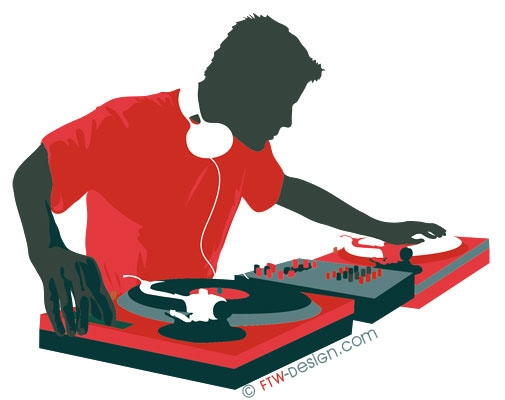Digging in the crates: an ethnographic study of DJS' work
http://dl.acm.org/citation.cfm?id=2208314
Authors:
Ahmed Y. Ahmed - University of Nottingham, England
Steve Benford - University of Nottingham, England - Professor of Collaborative Computing and Head of the School of Computer Science at The University of Nottingham. He is also a member of the Mixed Reality Laboratory and of Horizon.
http://www.mrl.nott.ac.uk/~sdb/

Andy Crabtree - University of Nottingham, England - Associate Professor who's work includes the relationship between computing systems and social interaction.
http://www.andy-crabtree.com/ethnography/work.html
Summary:
Ahmed, Benford, and Crabtree decided to perform a study on electronic music DJ's to decipher their impact on venues, dancers, and events while also highlighting the individual leaps they have to hurdle through to be competitive in this occupation. They adopted an ethnomethodological approach and followed some DJ's around the UK for a while. They would follow the DJ's into clubs on a day-to-day basis and take pictures, notes, and videos.
In order for DJ's to begin their job, they need to amass a music collection. There are 4 key steps to gathering such a collection and these steps are: buying new releases, crate-digging, gift-giving, and making beats. For buying new releases, the DJ's strictly adhere to the vinyl and digital download formats. Digital downloads can be cheaper and have some instant gratification but the vinyls are important for rediscovering tracks in ones own collection.
The second step to amassing a collection is crate-digging. Crate-digging involves going to old record stores, garage sales, online venues, or any other place that might sell old records and buy them. The object here is to find tracks that not many people know about and make them your own. This can distinguish one DJ from another and give him a unique style. Gift-giving is sharing tracks between DJ's. Usually this happens between DJ's who can somehow promote each other mutually through podcasts or FM channels. They will not just give out their tracks to some individual who mixes as a hobby. The final step is making beats. This allows individual artists to transform and come out onto a plain of their own. They then need to book venues and if they get popular, can charge more on the prices.
The authors picked out some broader implications from this study. They mentioned value of tangible media is important because it is harder to get than digital media that everyone has access too. It also allows for physical control on a turn table. The importance of the crate is also important. The crate is their bag of vinyls that they can customize for each show to make them stand out. Sharing and hiding one's music is vital since there needs to be some rapport within the community but not enough to reveal all of one's secrets. Finally, performance etiquette plays a big role within the DJ world. For instance, it is bad to ask a fellow DJ to borrow a record. The authors conclude there is room for heavy technological change within the field.
Related Papers:
http://dl.acm.org/citation.cfm?id=1056808.1056850&coll=DL&dl=ACM&CFID=152552719&CFTOKEN=58424707
http://dl.acm.org/citation.cfm?id=1690388.1690411&coll=DL&dl=ACM&CFID=152552719&CFTOKEN=58424707
http://dl.acm.org/citation.cfm?id=965400.965556&coll=DL&dl=ACM&CFID=152552719&CFTOKEN=58424707
http://dl.acm.org/citation.cfm?id=1291233.1291413&coll=DL&dl=ACM&CFID=152552719&CFTOKEN=58424707
http://dl.acm.org/citation.cfm?id=604045.604089&coll=DL&dl=ACM&CFID=152552719&CFTOKEN=58424707
http://dl.acm.org/citation.cfm?id=1291233.1291343&coll=DL&dl=ACM&CFID=152552719&CFTOKEN=58424707
http://dl.acm.org/citation.cfm?id=846222.847728&coll=DL&dl=ACM&CFID=152552719&CFTOKEN=58424707
http://dl.acm.org/citation.cfm?id=371920.371921&coll=DL&dl=ACM&CFID=152552719&CFTOKEN=58424707
http://dl.acm.org/citation.cfm?id=1142405.1142418&coll=DL&dl=ACM&CFID=152552719&CFTOKEN=58424707
http://dl.acm.org/citation.cfm?id=985692.985734&coll=DL&dl=ACM&CFID=152552719&CFTOKEN=58424707

This study was not that novel, but that's not to say it lacked depth. The first paper I linked mentions a new technology for DJ's. The mixxx technology automatically syncs the tracks for the DJ so his hands can be free for other tasks. It looks like the authors had some foresight as this field will most likely change drastically over the next decade if it already hasn't been. The second article, Wearable DJ system: a new motion-controlled DJ system, talks about a wearable DJ system so that the artist can move around more when he or she performs. One of the main problems was that DJ's were rooted place when they were mixing and hopefully this will alleviate that problem.
Evaluation:
Ahmed, Benford, and Crabtree evaluated this project rather poorly. Due to the nature of the study, this is understandable. There was a ton of qualitative data from a few DJ's that they followed which were mostly opinionated on how they ran things individually. This means not much quantitative data existed for this project besides maybe a consensus on how each DJ they interviewed did things. The interviews were highly subjective once again since they were opinionated and did not represent the views or practices of all DJ's. There was not much objective data either besides detailing the few musical formats they use.

Discussion:
Being into music and interested in the DJ scene, I found this paper to be very interesting. I do not however find it very novel. There have been plenty of other studies on DJ's. One comment by the authors that I particularly found interesting was that they said there was a lot of room for change in the near future, yet some of the inherent needs of DJing keep it somewhat retro. One example is that they require vinyls that not many people know about which is at odds with technology or digital formats. I am most curious about the changes that might happen in the days to come. Some of the papers I linked detailed new DJ equipment that could change the occupation altogether.
No comments:
Post a Comment